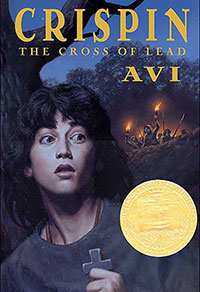
The story of Crispin: the Cross of Lead is complex.
- My wife and I were driving from Denver to the mountains, listening to a lecture by Dr. Teofilo Ruiz, chair of the History Department at UCLA. It was all about the medieval period. I was fascinated, and told myself that surely there was a story here, and I must do some reading.
- I did read a lot more—found wonderful stuff—and began to shape a story in my head.
- I also had a dream—I think it was a dream—and it was about an extended medieval story which I would write in four parts. The dream told me the beginning, the middle and the end. An orphan boy was in it along with a large man who befriends him.
- I wrote a first draft, but decided I had to go to England to do more research. When in London I went to the British Museum, the medieval section. There I saw a case of lead crosses, given to people during the period of the Black Death. Only then did I incorporate the key lead cross into the story.
- The story takes place when the English spoke Middle English. How to suggest a different, but readable English? The first draft was written in verse, in a form of unrhymed poetry used in 14th Century England. [Chaucer, Langland] The resulting number of pages was much too long, so I collapsed the lines, but all the same, much of the book remained in iambic pentameter. I just never mentioned that to anyone.
- Meanwhile editor A at Publisher B asked me if I would publish with her. I said, yes. A contract was signed but no book was stipulated.
- Crispin, at the time titled No Name, was submitted to editor C at Publisher D.
- Editor C decided the book, in the draft I had submitted, was not what was wanted.
- Meanwhile, A had resigned from publisher B.
- No Name was offered to publisher B
- Since the editor at Publisher B, the one who had offered the contract, was no longer there, No Name was assigned to Editor E.
- The revisions were long and arduous, none more so than the opening pages.
- The book was published with the title Crispin: The Cross of Lead. It was dedicated to Dr. Ruiz, that fellow whose lecture gave me the idea for the book. It got fine reviews, but I am not one to have expectations about awards. In any case, I was working on another book.
- ALA Midwinter is when the Newbery Award committee gathers and announces the award on Monday morning. The conference is not one at which many authors attend. For the only time in my writing life (before or since) I was invited to attend to support another book of mine, the picture book called Silent Movie.
- At the Conference I had the worst case of flu I have ever had. I was sick to the degree that I was shivering. Whenever I could, I fled to my hotel room, got under a blanket and was sick. The worst time was sitting at Sunday breakfast with a few members of the Newbery committee, although at the time I didn’t know who they were. I was in no mood to chat. I excused myself and flew home, changing my flight so I could leave Philadelphia as quickly as possible.
- Back home Monday morning at 5 AM (still ill) I was on my computer rushing to rewrite my daughter’s letter of application for a summer job, when the phone rang. It was the chair of the Newbery Committee, Starr Latronica. “Congratulations,” she said, “you have won the Newbery Award.”
- In truth, my first thought was, “The next book better be good.”
- I hung up the phone, and burst into tears.
- “What’s happened?” asked my wife.
- I said, “I won the Newbery award.”
- All my flu symptoms vanished.
What did I learn from all this? If you get a bad case of the flu, winning the Newbery award will apparently cure you.
3 thoughts on “Story Behind the Story #43: Crispin: The Cross of Lead”
This was fascinating, Avi. And funny. And moving. I love this series of posts.
So honored to have been on the other end of that Newbery flu-be-gone phone call, Avi. Thanks for sharing this Behind-the-Book glimpse into CRISPIN.
My 6th grade Lit class has been loving this story for years. Some parts of the “Story Behind the Story” you shared during our classroom Google Meets (and before that, Skypes!) The story about your illness being cured by winning the Newbery was a new, delightful detail. Thanks for sharing your stories, your love of reading, your craft of writing, and your humor!